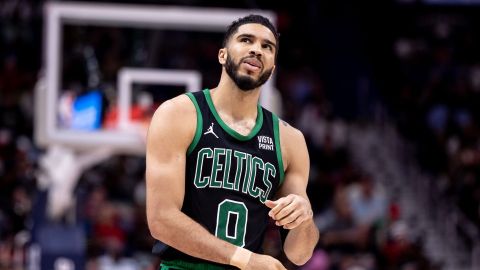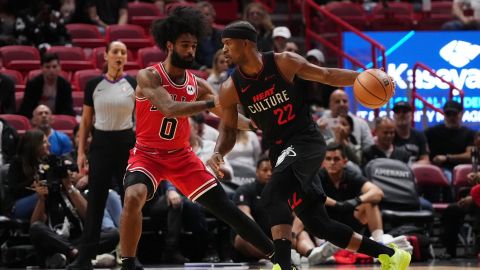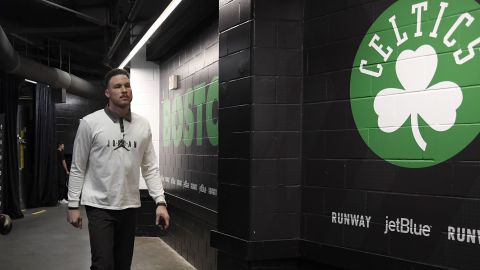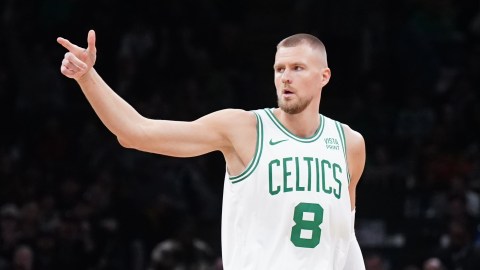 BOSTON — Weren’t they supposed to be past this?
BOSTON — Weren’t they supposed to be past this?
When the Boston Celtics traded away Courtney Lee, Jordan Crawford and MarShon Brooks, then excused Keith Bogans indefinitely, within a span of two weeks, the team’s backcourt logjam was supposedly relieved. When Avery Bradley sprained his ankle against the Miami Heat, the Celtics actually had a shortage of guards at coach Brad Stevens’ disposal.
Now Bradley is back, though, and Stevens is essentially right back where he started. He has a bunch of bodies deserving of minutes and only so many lineup slots to use them in. This is all Chris Johnson’s fault.
Johnson wasn’t supposed to emerge as a key cog in Boston’s crunch time rotation when he signed his initial 10-day contract on Jan. 17. Most 10-days are a tacit agreement between a team and a player, and Johnson’s was no different. Celtics president of basketball operations Danny Ainge gave Johnson a handful of games to prove he could be a bit player at the NBA level; in exchange, Johnson served as insurance in case disaster struck.
It did.
Bradley’s injury created an opportunity for Johnson against the Heat, and he seized it. Johnson scored 11 points on 4-for-7 shooting in a shockingly narrow loss in Miami. Suddenly, he wasn’t just practice fodder. During Bradley’s 5 1/2-game absence, Johnson averaged 9.6 points per game while shooting 47 percent from the floor and 41 percent from three, earning a second 10-day deal along the way. When asked why the Celtics decided to keep Johnson around for another 10 days, Stevens was only slightly exaggerating when he said, “because he’s been our best player.”
At some point, Johnson’s run figured to end. But with Bradley returning to the court Sunday, Johnson showed no signs of fading away. Stevens once again has a glut of guards — Rondo, Bradley, Johnson, Jerryd Bayless and Phil Pressey — and only two backcourt spots at any given time.
“It’s difficult,” Stevens said. “Obviously, Avery is a guy that has been here, so he’s been around us and done everything else [besides play]. It’s been tough juggling all of those things in the past few weeks, just because we’ve been shorthanded for a number of reasons, mostly personnel changes and injuries. But I think the guys have done a reasonable job when called upon in those tough circumstances. Hopefully, as we get more bodies, we can become a little bit more consistent.”
Unfortunately for Johnson, his emergence might mean his departure from Boston. No matter how well he has played, he is at the bottom of the hierarchy due to his contract status. The Celtics can let him go Thursday with no further cost to them, while re-signing him would mean extending his contract through the end of the season. With four healthy, NBA-caliber players at the ready, the Celtics could always grab another cheap D-Leaguer if need be.
The beauty for Johnson is that he’s almost assured of getting another chance. He’s been too good in his three-week stint in Boston not to get picked up somewhere. He served a 10-day deal with the Memphis Grizzlies last season, and he was in camp with the Orlando Magic this preseason. He’s been on the fringes of the league for a while, and his performance with the Celtics might have cemented his status as an NBA bench player.
That said, Stevens and the Celtics do not appear ready to move on so easily. Bradley and Johnson actually shared time on the court with Rondo for extended fourth-quarter minutes in a close game on Sunday. The small-ball lineup was part of a three-guard approach Stevens used throughout the game, starting with a Bradley-Bayless-Pressey combination in the second quarter. Unlike previous three-guard lineups Stevens has used, this wasn’t simply a reaction to the other team’s group. Stevens was creating mismatches, rather than responding to them.
Bradley’s tenacity as a defender and Johnson’s length at 6-foot-6 allowed Stevens to use them against taller, longer wing players like Orlando’s Maurice Harkless. The Magic went so far as to put noted defender Arron Afflalo on Johnson defensively. That freed up Bradley and Rondo, smaller yet superior offensive players, to attack the likes of Victor Oladipo, who is a defensive menace in the making but is still a mistake-prone rookie for now.
There is one major difference between the Celtics’ backcourt predicament then versus now: money. Lee, Crawford and Brooks made a combined $8.5 million, which has turned into about $100,000 for Johnson, according to the salary site ShamSports. The Celtics aren’t better on the court in their current incarnation, but they are cheaper and more flexible. That remains the case regardless of whether Johnson sticks around.
With Bradley’s return and Johnson’s 10-day contract coming to an end, Ainge has a tough decision to make this week. But it’s not nearly as tough as the decisions he has already made — or the ones ahead. Ainge and the Celtics only wish all their moves could work out this well.
Have a question for Ben Watanabe? Send it to him via Twitter at @BenjeeBallgame or send it here.



